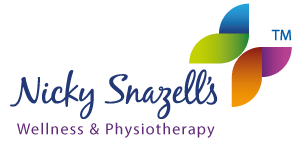Struggling with pain that just won’t go away? Tired of feeling like you’re just another number in the healthcare system? At Nicky Snazell Clinic, we believe in a different approach—one that puts you and your needs first, offering not just relief but a path to a better, pain-free life.
For those of you who have been with us for a while, you already know the effort we put into making our clinic a special place. But it’s always worth taking a moment to reflect on what sets us apart and why that matters for you.
A Relaxing Escape Right on Your Doorstep
Our clinic, tucked away in the tranquil Staffordshire countryside, is more than just a place for treatment—it’s a space designed for your comfort and relaxation. The beautiful, restored grade II barn offers a welcoming retreat from the hustle and bustle of daily life. From the moment you walk through our doors, you’re greeted with a warm smile and a cosy atmosphere. Whether it’s the inviting sofas, the freshly brewed ground coffee, or the crackling fire on a cold winter’s day, we want you to feel at home.
We know that a calm mind is key to recovery, which is why we’ve put so much care into creating an environment that helps you relax. And of course, easy parking and direct access to the building mean that your visit starts smoothly, even before your treatment begins.
A Team That Cares Like Family
At the heart of our clinic’s success is our exceptional team. When we select new members—whether for therapist roles or administrative positions—we look for more than just technical expertise. We seek individuals who are team players, with a positive and caring attitude. This helps us maintain the warm, “part of the family” feeling that defines the Nicky Snazell Clinic.
Because we have advanced technology and skills not found elsewhere, the ability and desire to learn are paramount for every team member. To ensure our team stays at the cutting edge, we provide ongoing professional development through weekly CPD (Continuing Professional Development) sessions and bring in third-party experts for in-house training. This commitment to learning means that every member of our team is always ready to deliver the highest standard of care.
Advanced Technology, Traditional Care
One of our core beliefs is that effective pain relief requires both time-tested hands-on care and the right technological support. While we don’t have advanced imaging like MRI on-site, we’ve built strong partnerships with third-party providers to ensure you have access to high-quality imaging when needed. And the best part? We can secure competitive rates and rapid turnaround times, so you won’t be left waiting for answers. This ensures that you receive a swift and accurate diagnosis, enabling us to tailor your treatment effectively.
A Clinic Built on Passion, Experience, and Continuous Learning
Nicky Snazell’s lifelong dedication to helping people overcome pain is the heart of our clinic. Her journey has taken her from the UK to places like the USA, Canada, Korea, and China, where she sought out the best techniques in pain management, including GunnIMS. Her holistic approach, detailed in her first book The 4 Keys To Health, ensures that every client receives a tailored plan that addresses not just the symptoms but the underlying factors of their condition.
Alan, Nicky’s husband, joined the clinic with a vision of contributing in a meaningful way. Despite coming from a successful career as the Group Managing Director of six aerospace companies, he recognized the need to deepen his understanding of healthcare. Alan took this challenge head-on, studying anatomy and massage for a year, followed by a course in deep tissue massage, and then two and a half years of Chinese Medicine in London. He spent countless hours shadowing Nicky during over a thousand assessments and treatments, learning the nuances of client care and mastering the use of all our advanced technology.
For several years, Alan treated clients directly, applying his skills and knowledge to help them manage pain. His experience in hands-on care, combined with his technical expertise, provided a unique perspective that now informs every decision he makes in his current role. As the clinic grew, Alan transitioned to focus on administration, marketing and strategy, bringing a blend of hands-on knowledge and business acumen that has been instrumental in shaping the clinic’s direction.
A Focus on Lasting Results
We often see clients who first come to us for an acute problem, like a sports injury or back pain. But as many of you know, our approach doesn’t end there. For those managing chronic conditions, a little maintenance care can go a long way. Regular, but infrequent, treatments—often just four times a year—can make all the difference, helping to keep you active, pain-free, and enjoying life.
This preventative care not only keeps flare-ups at bay but also ensures that you don’t need more intensive treatment when problems arise. It’s about looking after your health, so you can keep doing the things you love without being held back by pain.
Thank You for Being Part of Our Family
At the Nicky Snazell Clinic, our clients aren’t just numbers—they’re part of our family, and we understand the importance of living a pain-free life. We’re here for you, just as you’ve been with us, and we’re always looking for ways to offer the very best care and support.
Thank you for trusting us with your care, and for being part of what makes our clinic such a special place. Here’s to many more years of health, healing, and happiness together.
There are various types of massage and often the most avoided is Deep Tissue, simply because the name is a bit scary and it sounds painful. But be under no illusion, Deep Tissue Massage opens pandora’s box to feeling in less pain, more flexible and healthier than you have in your life.
Find out more about how deep tissue massage can benefit you.
There are lots of different types of massage and each have their benefits and weaknesses.
Swedish
If we start with Swedish Massage, this is the softest variety and is wonderful for just wanting to feel pampered and relaxed. Therapeutcally, however, its benefits are marginal at best and what it does provide is short lived.
Sports Massage
This is a step up from Swedish and tends to be provided by therapists who are trained in human anatomy, so understand which muscles are most likely linked to a given problem, and can treat that accordingly. It’s generally a stronger type of treatment than Swedish and if the therapist is focussing on a localised problem, can cause pain that varies from uncomfortable to strong. There are two things to note here. First, resolving painful knots is obviously going to aggravate things and cause more short term pain but, and this is the kicker, the pain level will subside quickly as the problem is resolved in follow on massages.
Deep Tissue Massage
Sports massage can be highly effective in treating more superficial problems, but sometimes the techniques simply won’t get in far enough for deep seated problems. In such cases, the big guns need to brought out, so that the treatment can get in deep enough to be effective. At the same time, however, there are also relatively shallow problems that sports type massage could easily reach, but the added pressure used in deep tissue massage is way more effective.
That effectiveness, however, does come with more pain - for the first few treatments that is. Yes, it’s a bit of ‘no pain, no gain’, but for those willing to accept this, the gains are substantially greater and once gained, most are reluctant to lose them again. Put simply, a body regularly treated with deep tissue massage, will feel at a level above it has ever felt before.
(Interesting fact- In Germany, Doctors often prescribe a course of Deep Tissue Massage in preference to drugs as their first line of defence. Now why would they do that unless it really works?)
Emotional pain likes to hide out deep in the body, deep in a pit, so much so, it’s like an archaeological dig to find it. Such pain is caused throughout our life whenever our body experiences emotional trauma, responding by going tense, our fight or flight response. This shuts down oxygen to some muscles and viscera and that’s usually a time of intense anger or fear. Emotional notes, as well as physical pain are a physical manifestation of what our emotions are at that time, and unfortunately can become imprinted within our bodies and reside there, the cause long forgotten, locked in for years like unexploded land mines.
A deep tissue therapist can then unwittingly come along in search of deep tissue trigger points, the aim being to release physical pain and tension, only to be bombarded by a huge emotional release as the land mine explodes.
The good news is that this release is a vital step to a long term resolution of pain.
The deep trigger points can be treated with deep tissue massage, applying focussed pressure, encouraging the muscles and fascial tissue to relax, releasing toxins and improving oxygen flow. The latter is important as restricting the oxygen supply can upset the nerves and cause chronic super sensitivity within those nerves. The result of this is the birth of chronic painthat won’t ever go away.
When we release these trigger points, you must understand there is a lot of emotional baggage that can go with it. It thus helps if your therapist can also work with a healing ability and so heal the emotion as it erupts.
This why deep tissue massage is such a wonderful treatment, alongside deep seated physical release, you have a treatment for mental wellbeing.
In some situations, curing a deep seated, stubborn pain might need a finely focussed deep needling technique called GunnIMS, and in this we are blessed by having one of the very top practitioners in the UK at our clinic.
If this is something that calls to you, pick up the phone and let’s chat.
If you are in pain, we can help
or call 01889 881488
Jean, Erica & Charlotte will be happy to help
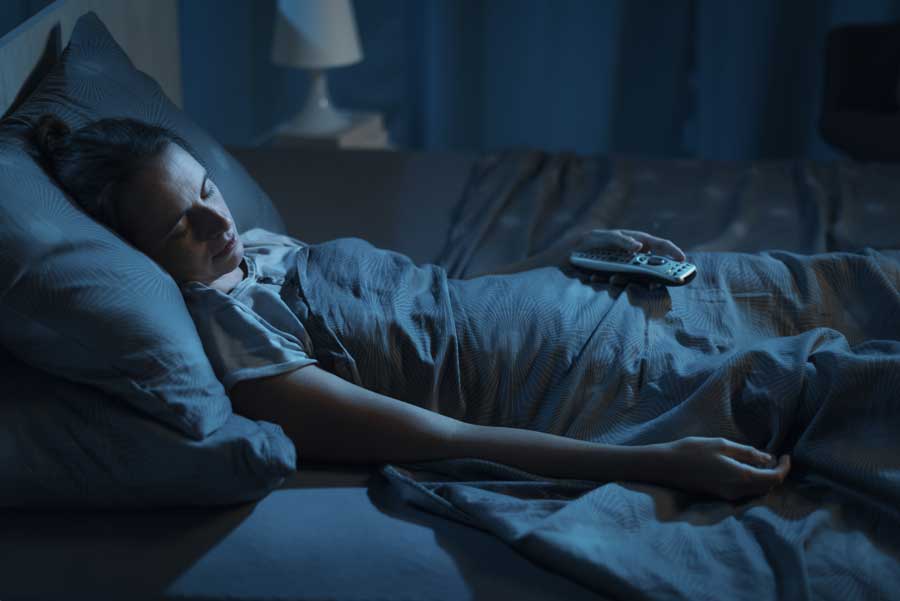
Who doesn't love the feeling of a good night’s kip?
Yet, many of us complain either of not getting ENOUGH sleep or good enough QUALITY of sleep to have us springing out of bed like a child on Christmas morning, ready to take on the day.
While sleep is far too complex a topic to sum up in numbers only, being aware of some of the basic statistics about sleep can help you to grasp just how prevalent a problem sleep deprivation is, and how a lack of Z’s can have a much wider impact on your health than you may expect.
the stats
- Approximately 10-30% of adults struggle with ‘chronic insomnia’, rising to 30-48% in older adults
- Women are 40% more likely to experience chronic sleep deprivation relative to their male counterparts
- 5 million Brits routinely have less than 5 hours of sleep per night
- Over £40 billion is lost to the economy annually due to sleep deprivation
- In a 2007 study of 10,000 people, those with insomnia were five times as likely to develop depression as those without.
- According to a 2004 study, people who sleep less than six hours a day were almost 30 percent more likely to become obese than those who slept seven to nine hours.
WHY IS SLEEP SO IMPORTANT?
Other than feeling energised and well rested, sleep is CRUCIAL for a number of our bodily processes, including ‘cognitive processing’ (the organising and retaining information), hormonal rebalancing and growth and repair, to name a few.
As physios, we are primarily interested in a hormone called ‘growth hormone’, which gets released into the blood stream during REM (Rapid Eye Movement) sleep to help repair soft tissue structures all around the body. Routine disruption to your sleep cycle therefore, doesn’t just leave you feeling dog-tired; it can also have a significant impact how well you heal from injury, and can adversely affect subsequent pain levels.
WHAT IS GOOD ‘QUALITY’ SLEEP?
The recommended number of sleep hours for the average adult is 7-9 hours, but why is this so universal?
Sleep as a process can be broken down into 4 key stages, with a whole cycle taking approximately 4 hours to complete. For optimal sleep, it is recognised that most people need to complete 2 full sleep cycles per night, ideally undisturbed!
When we consider 3am trips to the bathroom, snoring partners, pets in the bed, late night working, and too much caffeine, that earlier statistic doesn’t appear to be so shocking now does it?
So what can you do to set yourself up for sleep success?...
TOP 5 TIPS FOR A GREAT SLEEP
To set yourself up for a great night sleep, it’s best to think of easy and manageable changes you can make immediately to help your tune into your body and brain clock.
- Set a firm time for sleep and for waking
Setting a firm routine for when you go to bed and when you wake isn’t just for children. Following a set time, across a 7 day week, helps to tune your body and brain clock into a regular rhythm, signalling when it’s time to sleep and when to rise. After some time, this rhythm becomes engrained, making it automatic.
- Check your room temperature
When asleep, our body temperature naturally reduces by 1-2 degrees, therefore ‘overheating’ can be a common cause of sleep disruption. Turning your bedroom temperature down to an optimal 18 degrees avoids disturbance to your sleep by keeping your body temperature more stable.
- Utilise your sense of smell
Certain smells can help to induce sleepiness. Placing calming smells like lavender (pillow spray, essential oils) in the sleep environment / bedroom can help to trick your brain into winding down for sleep.
- Don’t eat at least 2 hours before bed
Ingesting food close to bedtime signals “wakefulness” to the body/brain, as there is now a need for food to be digested. Where possible, have your last mouthful 2-3 hours prior to sleep, which includes milk in coffee/tea.
- The two S’s rule
Your brain makes connections between spaces and activity. Try and utilise the bedroom for the two S’s - sleep and sex only. Where possible, keep laptops, iPads and mobiles out of the bedroom to limit the temptation for late night working/ scrolling.
If your poor sleep is due to Pain through back, legs, hips or neck for example then you can consider seeing a Physiotherapist at Pain Relief Clinic to help relieve this pain for more undisturbed sleep.
If you are stressed, then you can also consider a massage at our Stafford clinic.
If you found this article useful, check out our other health blogs,
also available on the website.
One of the first questions any patient asks when obtaining an injury is ‘how long until it gets better’... If only an answer were simple.
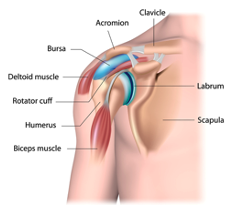
Unfortunately, when it comes to the shoulder joint, the answer isn’t straightforward at all because your shoulder is one of the most complicated joints in your body.
To achieve the wide range of movement that the shoulder provides, it requires a combination of muscles from body to shoulder blade (scapula), body to arm bone (humerus) and shoulder blade to arm bone. Due to this complexity, it is one of the most susceptible joints in the body to injury.
The shoulder is made up of three bones, the upper arm bone (humerus), the shoulder blade (scapula) and the collarbone (clavicle). There are joints between the clavicle and scapula and between the scapula and humerus.
The stability of the shoulder is predominantly controlled by four muscles, commonly known as the rotator cuff. They are tasked with keeping the joint properly centred and located.
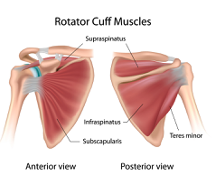 These are
These are
- Supraspinatus
- Infraspinatus
- Subscapularis
- Teres Minor
Common Shoulder Problems
The most common shoulder injuries are:
- Rotator cuff tears/tendonitis
- Impingement
- Instability
- Frozen Shoulder
- Bursitis
- Osteoarthritis
Rotator Cuff Tears
The rotator cuff muscles and tendons are an important part of the shoulder and are tasked with keeping the bones of the joint together across its wide range of motion. Rotator cuff tears account for more than 50% of shoulder injuries and are most common in people who repeatedly perform overhead motions. Thus athletes involved in sports such as swimming, racquet sports and weight lifting, which all require repetitive overhead movement, are particularly prone to injury.
Typical symptoms of a rotator cuff tear will be pain at night disturbing your sleep, and probably some lessening of pain during the day, although any overhead movement or even reaching behind your back is likely to be painful. You will also probably experience weakness in the affected arm. If left untreated, the pain will most likely increase over time.
Keen athletes may be tempted to continue in their favourite sport, in the hope that the pain will recede, but this will most likely aggravate the situation and, over time, may make the condition worse. If you suspect a rotator cuff tear, it is strongly advised to seek help from a qualified physiotherapist or sports therapist as soon as possible, as some conditions, such as a full-thickness supraspinatus tear, can become irreversible if left too long.
Impingement
Rotator cuff tendons can become trapped between a bony projection of the shoulder blade called the acromion and the top of the humerus (arm bone). Particularly prone is the supraspinatus tendon, this muscle is responsible for moving the top of the arm sideways from the body for about the first 15 degrees of arm movement.
Impingement problems can be caused by a number of factors, including:
- Loss of scapula – humeral rhythm
- Nerve interference or injury from the neck to the shoulder, causing abnormal movement of the shoulder
- Poor posture
- Tears and inflammation of tendons
Instability
Recent dislocation, sudden injury or overuse can each cause shoulder instability. The head of the upper arm bone can glide out of the shoulder socket (glenoid). This can occur when the capsule and ligaments that have the role of stabilising the shoulder in the socket have not healed properly and remain stretched making them too loose to keep the shoulder stabilised. This can result in repeated dislocations.
It is, therefore important to seek treatment. Rehabilitation and soft tissue work can be provided by qualified physiotherapists or sports therapists to help strengthen the muscles and ligaments and help to gain stability around the shoulder joint once more. It is advisable to seek help sooner rather than later.
Frozen Shoulder
This condition, medically described as adhesive capsulitis, can literally develop overnight. The capsule of the joint becomes inflamed and stiff, resulting in restricted movement. Eventually, the shoulder ‘freezes’ and becomes immobile for a few months to a year.
However, a frozen shoulder does typically progress in three main stages:
- Freezing stage- any movement of your shoulder causes pain, and your shoulder's range of motion starts to become limited.
- Frozen stage- pain may begin to diminish during this stage. However, your shoulder becomes stiffer and moving it becomes more difficult.
- Thawing stage- The range of motion in your shoulder begins to improve.
Bursitis
A bursa is a fluid-filled sac that act as a cushion to stop friction between the muscles and bones as they glide over on another. You have several in your shoulder, one being one of the largest in the body which is located towards the top of the arm.
After an excessive repetitive motion of the shoulder, the bursas can inflame and swell. The pain is normally a gradual onset located on the outside of the shoulder which can spread down the arm. It can become more aggravated when lying on the shoulder or if you’re using your shoulder anywhere from 60-90 degrees up and outwards.
When treating Bursitis, the aim is to control the inflammation. If you don’t seek help, often the pain will become worse and become impinged.
Osteoarthritis
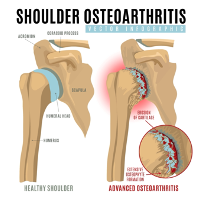 This is when the normally smooth cartilage that covers the ball and socket joint diminishes after constant friction leaving bone to grind against bone. It develops slowly and the pain worsens over time, normally after chronic wear and tear or work injuries. Symptoms may include swelling, pain, and stiffness.
This is when the normally smooth cartilage that covers the ball and socket joint diminishes after constant friction leaving bone to grind against bone. It develops slowly and the pain worsens over time, normally after chronic wear and tear or work injuries. Symptoms may include swelling, pain, and stiffness.
Osteoarthritis is a chronic problem which cannot be resolved, but the symptoms of the condition are amenable to pain-reducing treatment.
Every shoulder injury will present differently, and everyone’s perception of improvement will be different too. For example, one patient may be over the moon for gaining an extra 10 degrees in pain-free shoulder motion. Whereas the next will be happy only when gaining their full range of motion back.
Many biological, psychological, and social factors are involved during the recovery process after a shoulder injury.
If you are suffering from shoulder pain, we can help
Call 01889 881488 Now
Jean, Erica & Charlotte will be happy to help
The elbow joint is a synovial hinge joint in the arm and consists of three main bones: The humerus of the upper arm, the radius and ulna of the forearm. The elbow joint enables us to bend and straighten our arm.
Tennis Elbow
This is a condition that causes pain on the outside of your elbow. It is mostly caused by overusing your forearm from repetitive or strenuous motions. If these motions are a normal part of your daily routine, then resolving your tennis elbow pain can involve quite a lot of time and treatment. In the interim, you may only get bouts of temporary relief. Permanent relief will probably necessitate a change in your daily routine and a fair degree of patience. Needless to say, tennis elbow problems should always be referred to qualified therapists with access to suitable technology, such as shockwave.
A simple but effective exercise involves doing light twists of the arm and bicep curls using a lightweight. The goal is to strengthen the tendons and the muscles in you arm. You can also stretch out the forearm by placing your fingers on a hard surface and pressing downwards, stretching out both the hands, the wrists, and the forearms.
Self-massage can also be helpful and can be found on YouTube. We also offer sports massage therapies in the clinic, ask for details
Golfers Elbow
Now the difference between tennis elbow and golfers’ elbow is that tennis elbow is inflammation of the tendon where it joins to the bone in the outer elbow and golfers elbow is inflammation of the tendon where it joins to a bone in the inner elbow.
Both injuries are overuse injuries that are caused by activities that require repetitive motion of the arm and wrist. The problems of resolving pain from golfers elbow are the same as for tennis elbow, covered above.
Occasionally, for both golfers and tennis elbow you may wear an elbow brace. The purpose of the brace is to redirect the pressure over your muscles so that the injured area doesn’t take full force.
Bursitis
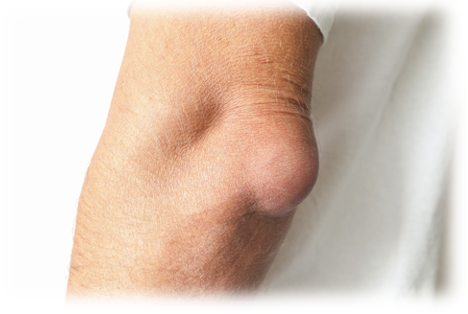 There are many bursae located throughout the body that act as cushions between bones and soft tissues, such as skin. They contain a small amount of lubricating fluid that allows the soft tissues to move freely over the underlying bone.
There are many bursae located throughout the body that act as cushions between bones and soft tissues, such as skin. They contain a small amount of lubricating fluid that allows the soft tissues to move freely over the underlying bone.
Sometimes the bursa may become irritated or inflamed, more fluid will accumulate in the bursa and a bursitis will develop. It becomes swollen, painful and worsens with direct pressure on to the elbow. The swelling can sometimes grow large enough to effect range of motion. It can also become red and warm to touch.
At Nicky Snazell’s clinic, you can receive two treatments for bursitis that will help alleviate acute and chronic pain. Deep oscillation and pulsed shortwave.
- Deep oscillation provides an electrostatic current that helps to increase blood flow, circulation and helps to enhance treatment outcomes as it proves symptomatic relief.
- Pulsed shortwave acts as a type of microwave that provides a high frequency electromatic energy into the body to help reduce pain and swelling. It works particularly well for bursitis.
A soft pad can ease discomfort.
Ulna nerve irritation
This occurs when the nerve in the arm becomes compressed or irritated. The ulna nerve is one of the three main nerves in the arm. It travels from your neck down into your hand and can be constricted in several places along the way.
The most common place for compression of the nerve is behind the inside part of the elbow. Ulnar nerve compression at the elbow is called ‘cubital tunnel syndrome. It can cause numbness and tingling sensations in the hand and fingers.
However, you should seek help from a therapist as there are a number of reasons you may be getting these symptoms. More often than not, the pins and needles sensation you may feel, in your hand, for example, can be coming from a different area of the body completely. It may just be referred pain you are experiencing.
Top tips to reduce the likelihood of elbow injury
- Seek early advice from a physiotherapist or sports therapist.
- Protect your joints during activity, especially during winter activities. Wear elbow pads and wrist guards
- Don’t throw through elbow pain.
- Maintain a good posture- this prevents elbow injuries from compensatory overuse.
- Consider a workstation set up, as elbow pain can develop with prolonged daily computer use with poor posture.
If you are in pain, we can help
Call 01889 881488 Now
Jean, Erica & Charlotte will be happy to help
A lot of you may have watched the commonwealth games this year and noticed a familiar location that the mountain bikers raced on. Cannock Chase has provided us with the opportunity to use this track whether to practice or cycle on for the experience. Whether you are interested in mountain biking over Cannock Chase, or road cycling and you want to do so while minimising your chances of injury, then here is some free advice given to you from our sports therapists at Nicky Snazell’s Wellness and Physiotherapy Clinic.
First, there are many ways to decrease your chance of injury and footwear is one factor you should consider.
Compared to running shoes, cycling shoes are designed with stiffer soles to help optimize your energy transfer. You should keep your foot rigid, so there’s no power lost through your feet and all the power from your legs goes directly into the pedal stroke. Additional support from clipping your shoes into your road bike will also help you to feel more secure when you are pedalling and can help prevent you from losing balance. It can also make you more aerodynamic as it has been noted that it is easier to get your torso lower toward your handlebars making you more streamlined increasing your speed.
That said, proper trainers are only part of the solution if you are struggling with any pain when cycling. Strengthening and conditioning the muscles in your legs and core region is essential for injury prevention. We can provide guidance, not only to stop and prevent pain occurring but to increase your cycling longevity and your performance.

What are the most common injury areas from Cycling?
The most common injury areas, more often due to overuse and poor technique are:
- Knee
- Lower back
- Neck
- Thigh
- Ankle
Specific diagnoses for these areas are:
- Anterior knee pain
- Lumbar or neck myofascial pain, a chronic condition affecting the muscles
- The iliotibial band running up the outside of the thigh
- Achilles tendonitis
If you are a keen cyclist, the chances are you have suffered from an injury throughout your training. Understanding how and why this is caused and taking steps to strengthen your weakness could be a game-changer for your performance.
Strength and Conditioning
The problem for many of us is that daily life can involve a lot of sitting at a computer screen all day and this can lead to poor posture and the important muscles in our trunk stiffening up and weakening. These core muscles, along with those in the buttocks and thigh are important tant in stabilising you during exercise. If these muscles become weak you are more likely to injure yourself from falls or strains.
What is Strength and conditioning?
The use of dynamic and static bodyweight and resistance exercises to improve your performance and reduce the likelihood of injury occurring. It is also used during injury recovery.
Why should I strength and condition?
- Injury prevention – helps to correct muscle imbalances and improve muscle activation, as well as increasing the efficiency of your running biomechanics which results in improved running performance.
- To be faster/ stronger
- To enjoy exercise more.
If this sounds like something you may need, book an appointment with one of our sports therapists to get the best possible guidance and treatment. As an athlete, you put so much effort into your training, it’s worth putting the effort into taking care of your body too. Prevention is just as important as recovery.
Call 01889 881488 Now
Erica, Jean and Charlotte will be happy to help
First, decide what your fitness goals are!
Patients often ask me, once their general fitness is much better, “How do I take the next step to train towards a specific sport?” Firstly, any current injuries should be assessed by an experienced physiotherapist or sports therapist. Then you need to decide on your goals. What are your goals? Stronger heart and lungs? A fit-looking body? To win at sport? To live longer?
Furthermore, you need to decide:
- which sports you want to concentrate on
- how vigorously you want to compete
- how long you want to be able to compete.
Everyone should exercise, but you need to set your personal goals of fitness and your own unique set of aims, as this will determine the most appropriate exercise and productive time you can spare for training. A fitness assessment with a personal trainer can establish your personal fitness goals and an injury prevention program can be formulated to attain your goals:
• Enhanced cardiovascular ability.
• Improved stamina and endurance.
• Better agility, flexibility, and balance.
• Stronger muscles and core strength.
• Slimmer body.
• Stronger bones.
• Clearer thinking and happier moods.
Ten Tips to Achieve Your Fitness Goals
1) Measure your heart rate just after vigorous exercise for 5 seconds, then after another minute for another 5 seconds. Multiply both by 12, then subtract one from the other. This gives you your speed of recovery, which is an indicator of your cardio fitness. As you get fitter, both your oxygen capacity and the ability of your enzymes to remove lactic acid will increase.
2) Mix up slow and fast pace in all activities. Athletes carry out long slow and short fast interval training for a good reason; the slow pace builds stamina and teaches the body how to cope with and eliminate lactic acid, as well as enabling muscles to store more glycogen for prolonged exercise.
3) Fast pace, on the other hand, comprises of short bursts of intense activity which boosts sugar metabolism and teaches the brain to co-ordinate the muscles at a faster pace, helping agility.
4) To avoid muscle injury due to tiredness, rest adequately as muscles need
48 hours to recover, plus good hydration and nutrition.
5) To achieve stronger muscles, lift a weight you can just manage between
8 and 12 lifts in about 50 seconds. Then, rest briefly between sets, as
lactic acid build-up will cause injury. Repeat. Rest a day in between. Add
2.5 kg to 5 kg maximum at each increase.
6) Exercised bones get stronger, so use resistance or weight-bearing exercises.
7) For a thinner body, sustained exertion will burn up calories and speed up the metabolic rate.
8) For a flexible body, complete slow, sustained stretches of 30 seconds when you are warm and pain-free. Stretch before your workout to reduce the chances of injury. Stretching after exercise reduces muscle soreness and promotes relaxation.
9) Clearer thinking is essential. Work out your pattern of mental alertness, the daily peaks and troughs. Plan a regular exercise program and see how it eliminates the ‘valleys’. Exercise-induced endorphins plus serotonin will reduce depression and pain.
10) For running, cycling and walking, get checked out biomechanically.
This means the alignment of foot joints to avoid knee pain, hip pain, and back pain.
A correct alignment will reduce wear and tear.
Do you need help in setting realistic goals, creating a plan and
ongoing help to get you there?
We Can Help
Call 01889 881488 Now.
Jean, Erica & Charlotte will be happy to help
So, how do you choose your physiotherapy clinic in seven easy steps?
-
Physiotherapy skills and qualifications
The most important question - is the physiotherapist appropriately qualified and is there any evidence of ongoing learning and development? Although principals remain consistent, the skills and style of approach can be different as can the aftercare. Please make sure you get reassurances of qualifications and can see ongoing development of therapists.
-
Clinic Location
If you need physiotherapy, it is important to consider a local physiotherapist or one that is convenient to you. At Nicky Snazell Clinic we do provide specialist physiotherapy to clients from all over the world who come to Nicky for healing, but in general, we would recommend that you consider a therapist who is within a commutable distance of your work or home location. A commutable distance is 40-60mins for the right care, Nicky Snazell Pain Relief Clinic service; Stafford, Lichfield, Cannock, Rugeley & Stone.
-
Style of approach
Like people, physiotherapists are all different. While we hope that they all subscribe to the highest possible standards and approaches, it is important that you make sure that from the initial consultation you feel connected with your therapist and their unique style of approach.
Consider the following:
- Have your questions been answered?
- Did you feel a connection with the therapist?
- Are you clear on the next steps?
- Did the therapist explain costs?
-
Getting to the root cause
Spending time to find the root cause of pain is more important than the treatment itself. We find some clients have pain that is the result of unresolved childhood issues, bereavement and work-stress for example. Without spending the time to really understand your unique situation, often it can be like treating the surface of the problem and not the long-term view of the issue.
-
Ongoing Physiotherapy care
Once your initial condition and pain are 'fixed', ongoing care is essential. As they say, prevention is better than cure, so periodic check-ups and follow-ups will help ensure that you are maintaining your health. We quite often treat sports injuries and also recommend massage for clients which can relax and rejuvenate you avoiding the aggravation of the problem area.
-
Other services
Sometimes you may receive physiotherapy which can show that you would benefit from other services such as electro-acupuncture, the aforementioned massage. Does your therapist offer other services to support your wellbeing?
-
Customer service
A good physiotherapy clinic has a team who can facilitate customer support and great customer service, like helping you to book your appointments, reminders and periodic communication in the form of useful insights, tips and observations to help.
If you are looking for a Physiotherapist why not give our team a call: 01889 881 488
How can I relieve neck pain? The first thing to understand is how this happened, neck pain can be caused by other conditions such as muscle weakness in the shoulders, perhaps lifestyles such as workplace seating or even sports. Take a moment to consider what could be causing yours. While doing this, think about the type of pain you have. Is it a strain or a trapped nerve?
What does a trapped nerve in neck feel like?

A trapped never typically feels more painful in certain positions, and the pain again can be shooting, described as electric or pulsing. A trapped nerve can throb and jolt when you are moving. A strain usually feels more like a burn or a tear; these sensations can be confusing, so please do not worry if you struggle to distinguish between the two - Our team can help you understand this better and decide the best ways to help you.
How long does neck strain take to heal?
A strain can take between 24-hours and a week to recover. If you are concerned Nicky Snazell can help you with pain relief, it is still worth considering what caused this. The underlying source is always the best way to provide you with long-term pain relief, and maintenance can reduce reoccurrence.
What is the fastest way to fix a stiff neck?
If you are not ready to consider treatment, we recommend gentle stretches and a gentle massage in-between cooling and warming treatments like an ice-pack and a hot water bottle/wheat/rice bag. Be careful when doing this yourself. If you are unsure how to manage this effectively, contact us.
Which massage is best for neck pain?
This depends on how you got the neck pain; if it was doing sports, then as you might expect, sports massage could be the proper treatment. Typically, massage is the right treatment for neck pain; manipulating the soft tissue can relax the problem and promote blood flow and healing.
Where can you go for help with neck pain?
Nicky Snazell pain relief clinic in Stafford can help with neck pain. Please view this page for more information on neck pain, or contact us. Our experienced team of physiotherapists will help you navigate your pain and provide the most effective advice to help you long term.
Like a traditional massage, sports massage more intensely manipulates the soft tissues and tendons. In addition, the masseuse uses more strength to purge the muscles, which helps to loosen and condition the essential structural integrity. As a result, you are less likely to become injured during sports or physical activity.
Sports massage also helps to promote blood flow, which can aid healing and recovery after intensive exercise, which is why you will often find sports massage administered before and after races at running clubs.
What are the common areas for sports massage?
- Typical sports massages include legs used by runners, athletes, hockey, cricket, and rugby players.
- As well as the common sports previously mentioned, Netball and Tennis are also popular with shoulder and lower back sports massage therapies.
- The lower back is also a widespread complaint from horse riders, and we have seen jockeys from all over the world.
What is a sports massage therapist?
A sports massage therapist administers the massage, 'a masseuse', and is often referred to as a therapist as this serves a purpose and not just for pleasure. Sports massage has more medical benefits than other massages which are for relaxation and wellbeing.
What is a sports massage like?
A sports massage is slightly more aggressive than a typical massage, so it can be somewhat uncomfortable initially; however, your therapist will discuss this with you throughout so that it is tolerable. The fact it is more aggressive should not put you off because the effectiveness of the sports massage is driven by the pressure placed on the soft tissues.
There are many reasons that sports massage is so good for you and keeps you injury-free. This article covers some of the reasons sports massage is good for you.
What is sports massage good for?
- It is good for legs, shoulders, lower back, knees, calves, and neck.
- It is good for keeping your joints stable and loose, reducing the risk of sports injuries.
- It is ideal for those who are physically active, runners and hikers.
- It is good for people who have previous injuries to stave off issues resurfacing.
How can Nicky Snazell Pain Relief Clinic help?
Pain relief clinic is here to help; you will see one of our very experienced team. From there, we will discuss your specific needs and then complete your wellness programme. Nicky and the Pain Relief Clinic look forward to welcoming you aboard. If you are a first-time client, then please use the contact form; if you are an existing patient, you can use the online booking form.
